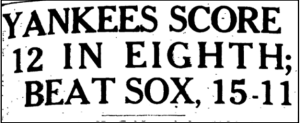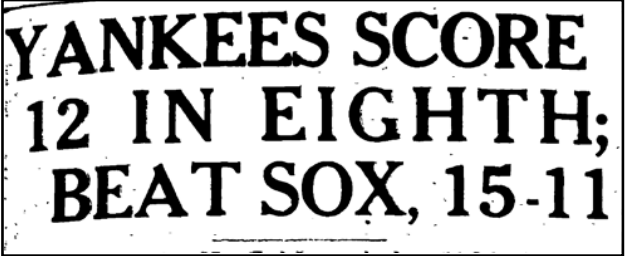May 27, 1933: Yankees score 12 runs in eighth for big comeback win
 The Yankees of the 1920s won six American League pennants and three World Series. After failing to win the pennant from 1929 through 1931, the Yankees won the World Series in 1932, and looked to repeat in 1933. As they took the field on Saturday afternoon, May 27, they were in first place by one game over the Washington Senators and 1½ games over the visiting Chicago White Sox. The White Sox had won the opener on Friday, and a Saturday win could knock the Yankees out of undisputed possession of first place. A close game through six innings suddenly turned into a rout for the White Sox – that is, until the Yankees scored 12 runs in the bottom of the eighth to pull off one of the greatest comebacks in their history.
The Yankees of the 1920s won six American League pennants and three World Series. After failing to win the pennant from 1929 through 1931, the Yankees won the World Series in 1932, and looked to repeat in 1933. As they took the field on Saturday afternoon, May 27, they were in first place by one game over the Washington Senators and 1½ games over the visiting Chicago White Sox. The White Sox had won the opener on Friday, and a Saturday win could knock the Yankees out of undisputed possession of first place. A close game through six innings suddenly turned into a rout for the White Sox – that is, until the Yankees scored 12 runs in the bottom of the eighth to pull off one of the greatest comebacks in their history.
New York’s star-studded lineup featured four of the core players – all future Hall of Famers – from the 1927 Yankees, perhaps the greatest team of all time. Earle Combs led off in center field, Babe Ruth (right field) and Lou Gehrig (first base) were batting in their usual third and fourth spot in the lineups, and Tony Lazzeri hit sixth at second base. At age 38, Ruth was coming to the end of his phenomenal career in what would be his next to last season with the Yankees. Still dangerous, however, Ruth hit .301 with 34 home runs and 104 RBIs in 1933. Gehrig, in his prime, at age 29, hit .334 with 32 home runs and 140 RBIs.1
In the seventh spot in the lineup was another future Hall of Famer, Bill Dickey, and batting eighth was the shortstop, 22-year-old Frank Crosetti, who went on to have a 37-year career with the Yankees, 17 as a player and 20 as a coach.2
The White Sox were a perennial second-division team.3 After having finished seventh in 1932, they were not expected to do much better in the new season. To be challenging for first place in late May was an unexpectedly pleasant surprise. Chicago was not without talent, with future Hall of Famers Al Simmons in left field and Luke Appling at shortstop. Jimmy Dykes, a future major-league manager, was at third base.
On the mound for the White Sox was Ted Lyons, another future Hall of Famer, in the midst of a 21-year career, all with Chicago. The Yankees started a 29-year-old rookie named Don Brennan, pitching in what would be his only season in the Bronx.
It was an ordinary game through seven innings. The Yankees took an early lead when Gehrig hit a two-run homer in the first. Chicago came back with three in the third before New York tied it with a run in the fourth. The see-saw continued as the White Sox regained the lead with a run in the fifth, with Lyons helping his own cause with his second single of the game.
It was 4-3, Chicago, going to the top of the seventh and that’s when the White Sox broke it open, scoring four times, including a two-run homer by Simmons. The rally sent Brennan to the showers, to be replaced by another former member of the 1927 Yankees, Wilcy Moore.4 After Lyons retired the Yankees in the bottom of the seventh, the White Sox had a commanding 8-3 lead going to the eighth. Things got worse for the Yankees in a hurry. With Walter “Jumbo” Brown now on the mound, the White Sox struck for three more.5 Now it was a laugher, 11-3, White Sox, in the middle of the eighth.
With Lyons on the mound, few could have expected what was about to occur in the Yankees eighth, especially after the leadoff hitter, Gehrig, flied out. Then Ben Chapman singled.6 Lazzeri and Dickey both walked. Crosetti singled to make it 11-4, leaving the bases still loaded. With the pitcher Brown up, Red Ruffing, a good hitting pitcher and another future Hall of Famer, was called on to pinch-hit.7 Ruffing singled, and it was now 11-5 with the bases still loaded. Combs walked, forcing in another run to make it 11-6. Finally, Lyons was gone, replaced by J. Walter Miller.8
The onslaught continued as Joe Sewell singled in another run to make it 11-7, leaving the bases full yet again. Things were getting interesting in the Bronx, with Ruth up as the tying run at the plate! Ruth singled to score two as the Yankees had their fifth hit of the inning – all singles – to go with three walks. Six runs were now in and it was 11-9, with Gehrig coming up.
Ruth and Gehrig, if nothing else, were great in the clutch and now with six runs in and two men on, Gehrig had a chance to put the Yankees ahead. Gehrig doubled to right, scoring one to make it 11-10 and leaving runners at second and third. Manager Lew Fonseca removed Miller, who did not get a single out.9 In came Eddie Durham with the game incredibly slipping away from the White Sox. After an intentional walk to Chapman loaded the bases again, the batter was Lazzeri. He came through with yet another single, with the runners again advancing only a single base. The Yankees had tied the game, 11-11.
Now it was Dickey’s turn, as the seventh player of the inning to bat with the bases loaded. There would be no single this time: Dickey hit a “prodigious blast” into the right-field bleachers for a grand slam.10 The Yankees had 12 runs in on eight hits (six singles) and three walks – they had gone ahead and now led by four runs – 15-11. The next two batters struck out, ending the inning.
Describing the eighth inning in the New York Times, John Drebinger wrote that “[it] shook both banks of the Harlem and confounded 20,000 spectators as the Yanks, in one of the most remarkable batting orgies ever staged by the world’s champions, piled twelve runs across the plate.”11
Taking no chances, Yankees skipper Joe McCarthy brought in yet another future Hall of Famer (and 1927 Yankee) to pitch the ninth. Herb Pennock, a left-hander, was then 39 years old in his 21st season in the majors. While Pennock gave up two hits, he kept the White Sox off the scoreboard and the game was over.
The White Sox had come so close to being within a half-game of the first-place Yankees. Instead, the elation of an apparent blowout victory had turned into a crushing defeat. Chicago never recovered; the White Sox went on to lose a doubleheader to the Yankees the next day, in the midst of losing six of seven games. In the blink of an eye, the White Sox had gone from challenging for first place on May 27 to 6½ games behind on June 2. They went on to finish sixth in the eight-team American League.
The Yankees won their next three games and 10 of their next 11 to take a six-game lead in the American League. They were in first place as late as July 23, before falling to second where they ended the season, seven games behind the Washington Senators.
Sources
In addition to the sources cited in the Notes, the author consulted Baseball-Reference.com and Retrosheet.org.
Notes
1 Combs, 34 years old, hit .300 in what would be his last season as a regular. Lazzeri was still only 29 and hit .294 with 18 home runs.
2 Crosetti wore the Yankees uniform from 1932 through 1964 and was a member of 17 world championship teams and 23 pennant winners, the most in both categories of anyone in baseball history.
3 When the American and National Leagues each had eight teams, those that finished fifth or lower were said to be in the second division.
4 The 36-year-old Moore pitched for the Yankees from 1927 to 1929 and then, after a stint with the Red Sox, returned to New York during the 1932 season. The 1933 season was his last.
5 Brown’s nickname derived from his 295 pounds on a 6-foot-4 frame. The 26-year-old was in his second season with the Yankees, part of a 12-year career playing for five teams.
6 In 1947, as the manager of the Phillies, Chapman verbally assaulted Jackie Robinson in Robinson’s debut season. The incident was portrayed in the biopic about Robinson, 42.
7 In 22 seasons and 1,937 at-bats, Ruffing had a career average of .269 with 36 home runs. As a pitcher, he won 273 games. After playing for the Red Sox beginning in 1924, Ruffing was traded to the Yankees early in the 1930 season and played the bulk of his career (through 1946) with New York.
8 Baseball-Reference.com lists him as “Jake Miller” without any reference to his name being “J. Walter.” Jake was his nickname but sportswriters in 1933 called him “J. Walter.” {See Chris Rainey, “Jake Miller,” sabr.org/bioproj/person/fef98ce5. Miller pitched eight seasons for Cleveland through 1931 but did not play in 1932, suffering from a “dead arm.” At the age of 33, Cleveland did not want him back and he failed to catch on with another team until the White Sox decided to give him a chance. “Finds Life in Dead Arm,” The Sporting News, June 1, 1933: 1. Miller pitched in 26 games for Chicago in 1933, with a 5.62 ERA. It was his final season.
9 Fonseca, 34 years old, was a player-manager in his last season as a player. He managed the White Sox for two full seasons (1932 and 1933) and 15 games in 1934.
10 John Drebinger, “Yanks 12 in 8th Subdue White Sox,” New York Times, May 28, 1933: 3, 1.
11 Drebinger. The 12 runs in an inning were two shy of the then modern day major-league record. As of May 2020, the modern-day record for most runs in an inning was 17 by the Boston Red Sox, against Detroit, on June 18, 1953.
Additional Stats
New York Yankees 15
Chicago White Sox 11
Yankee Stadium
New York, NY
Box Score + PBP:
Corrections? Additions?
If you can help us improve this game story, contact us.


